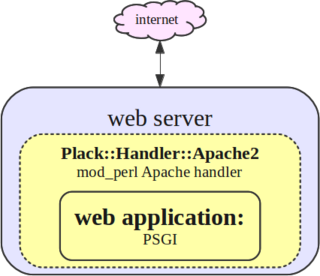
In computing, Common Gateway Interface (CGI) is an interface specification that enables web servers to execute an external program to process HTTP or HTTPS user requests.

HTTP is an application layer protocol in the Internet protocol suite model for distributed, collaborative, hypermedia information systems. HTTP is the foundation of data communication for the World Wide Web, where hypertext documents include hyperlinks to other resources that the user can easily access, for example by a mouse click or by tapping the screen in a web browser.
Short Message Peer-to-Peer (SMPP) in the telecommunications industry is an open, industry standard protocol designed to provide a flexible data communication interface for the transfer of short message data between External Short Messaging Entities (ESMEs), Routing Entities (REs) and SMSC.

SOAP is a messaging protocol specification for exchanging structured information in the implementation of web services in computer networks. It uses XML Information Set for its message format, and relies on application layer protocols, most often Hypertext Transfer Protocol (HTTP), although some legacy systems communicate over Simple Mail Transfer Protocol (SMTP), for message negotiation and transmission.

A web server is computer software and underlying hardware that accepts requests via HTTP or its secure variant HTTPS. A user agent, commonly a web browser or web crawler, initiates communication by making a request for a web page or other resource using HTTP, and the server responds with the content of that resource or an error message. A web server can also accept and store resources sent from the user agent if configured to do so.
OBEX is a communication protocol that facilitates the exchange of binary objects between devices. It is maintained by the Infrared Data Association but has also been adopted by the Bluetooth Special Interest Group and the SyncML wing of the Open Mobile Alliance (OMA). One of OBEX's earliest popular applications was in the Palm III. This PDA and its many successors use OBEX to exchange business cards, data, even applications.
In computer programming, a magic number is any of the following:

Modbus or MODBUS is a client/server data communications protocol in the application layer. It was originally designed for use with its programmable logic controllers (PLCs), but has become a de facto standard communication protocol for communication between industrial electronic devices in a wide range of buses and networks.
A query string is a part of a uniform resource locator (URL) that assigns values to specified parameters. A query string commonly includes fields added to a base URL by a Web browser or other client application, for example as part of an HTML document, choosing the appearance of a page, or jumping to positions in multimedia content.
Bencode is the encoding used by the peer-to-peer file sharing system BitTorrent for storing and transmitting loosely structured data.
The Web Server Gateway Interface is a simple calling convention for web servers to forward requests to web applications or frameworks written in the Python programming language. The current version of WSGI, version 1.0.1, is specified in Python Enhancement Proposal (PEP) 3333.
Real-Time Messaging Protocol (RTMP) is a communication protocol for streaming audio, video, and data over the Internet. Originally developed as a proprietary protocol by Macromedia for streaming between Flash Player and the Flash Communication Server, Adobe has released an incomplete version of the specification of the protocol for public use.

Byte serving is the process introduced in HTTP protocol 1.1 of sending only a portion of a message from a server to a client. Byte serving begins when an HTTP server advertises its willingness to serve partial requests using the Accept-Ranges response header. A client then requests a specific part of a file from the server using the Range request header. If the range is valid, the server sends it to the client with a 206 Partial Content status code and a Content-Range header listing the range sent. If the range is invalid, the server responds with a 416 Requested Range Not Satisfiable status code.
In computer programming, a netstring is a formatting method for byte strings that uses a declarative notation to indicate the size of the string.

Plack is a Perl web application programming framework inspired by Rack for Ruby and WSGI for Python, and it is the project behind the PSGI specification used by other frameworks such as Catalyst and Dancer. Plack allows for testing of Perl web applications without a live web server.
FastCGI is a binary protocol for interfacing interactive programs with a web server. It is a variation on the earlier Common Gateway Interface (CGI). FastCGI's main aim is to reduce the overhead related to interfacing between web server and CGI programs, allowing a server to handle more web page requests per unit of time.
Constrained Application Protocol (CoAP) is a specialized UDP-based Internet application protocol for constrained devices, as defined in RFC 7252. It enables those constrained devices called "nodes" to communicate with the wider Internet using similar protocols. CoAP is designed for use between devices on the same constrained network, between devices and general nodes on the Internet, and between devices on different constrained networks both joined by an internet. CoAP is also being used via other mechanisms, such as SMS on mobile communication networks.
The Asynchronous Server Gateway Interface (ASGI) is a calling convention for web servers to forward requests to asynchronous-capable Python frameworks, and applications. It is built as a successor to the Web Server Gateway Interface (WSGI).





